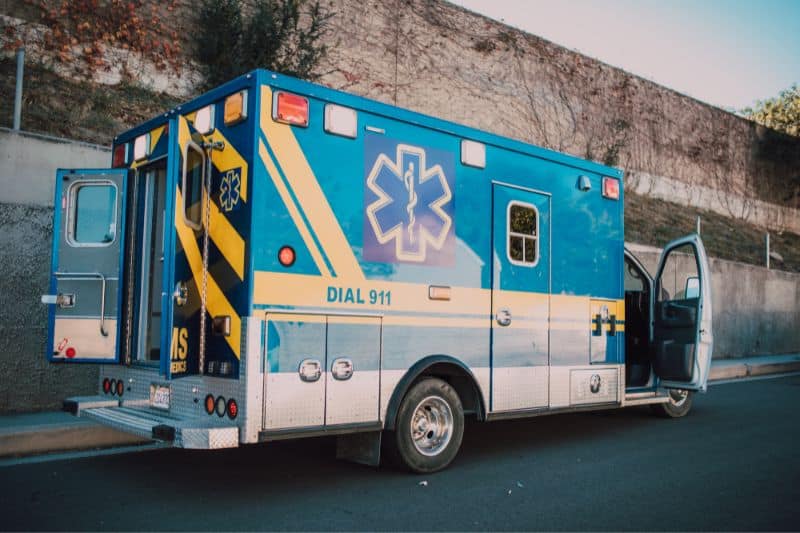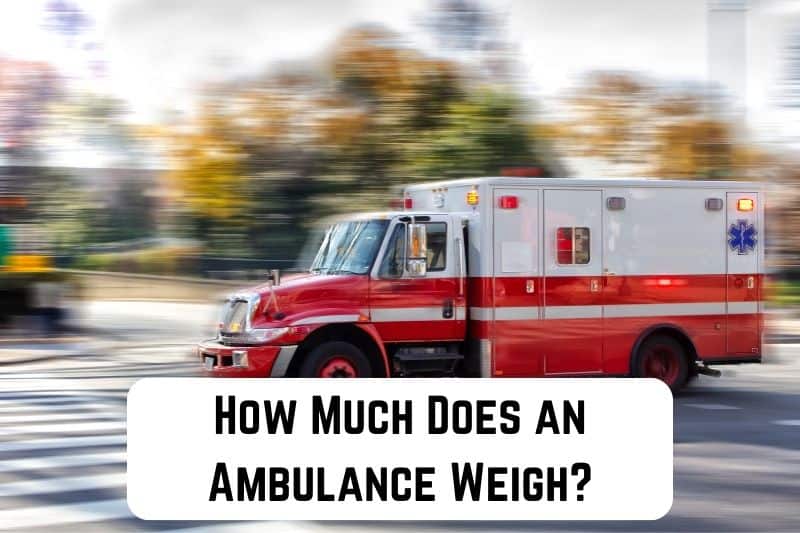Ambulances are crucial in emergency medical services, transporting patients needing urgent care to the nearest hospital. As you may have seen these medical vehicles speeding through the streets with their sirens on, you might wonder how much an ambulance weighs.
Knowing the weight of an ambulance can help you understand its maneuverability, safety, and fuel efficiency.
The weight of an ambulance can vary depending on factors such as its type, size, and the equipment it carries. Generally, there are different classes of ambulances, each with their own specifications and weight ranges.
In this article, you’ll learn how much an ambulance weighs and how these weight differences can impact their performance on the road.
Read: How Much Does a Dumpster Weigh? (Comparison Chart)
Type I ambulances typically weigh between 10,000 to 14,000 lbs (4,500 to 6,350 kg). Type II usually weigh between 9,000 to 10,000 lbs (4,080 to 4,530 kg). Type III weight is typically between 10,000 to 12,000 lbs (4,530 to 5,440 kg).
Measuringly.com
How Much Does an Ambulance Weigh?
When you think of ambulances, you might wonder about their weight. Don’t worry; we have got you covered! Let’s dive into how much an ambulance weighs.
Generally, the weight of an ambulance depends on its type and the equipment it carries. There are three main types of ambulances:
- Type I: These ambulances are built using a truck chassis, with a custom-made body on the back. They typically weigh between 10,000 to 14,000 lbs (4,500 to 6,350 kg).
- Type II: Built on a van chassis, these ambulances are smaller than Type I but still have enough space for necessary medical equipment and personnel. They usually weigh between 9,000 to 10,000 lbs (4,080 to 4,530 kg).
- Type III: These ambulances are built on a cutaway van chassis, offering a larger compartment for medical equipment and personnel. Their weight is typically between 10,000 to 12,000 lbs (4,530 to 5,440 kg).
Remember that an ambulance’s weight can vary based on factors such as the manufacturer, fuel type, and added equipment. For instance, adding extra medical supplies, stretchers, and other essential equipment can increase the ambulance’s overall weight.
When considering the weight of an ambulance, it’s also important to consider the Gross Vehicle Weight Rating (GVWR). This rating refers to the maximum weight that the ambulance can safely carry, including its passengers, supplies, and equipment.
For example, a Type I ambulance with a GVWR of 14,500 lbs (6,577 kg) should not be loaded with more than 14,500 lbs of total weight to ensure safe operation.

Weight of Different Types of Ambulances
Emergency Ambulance
When you think of an ambulance, the emergency ambulance is likely the image that comes to mind. These vehicles are designed to transport and treat critically ill or injured patients rapidly.
Emergency ambulances typically weigh between 10,000 and 14,000 pounds (4,536 to 6,350 kg), depending on the size and equipment onboard. The chassis, patient compartment, and additional features such as onboard oxygen or advanced life support equipment can all contribute to the overall weight.
Non-Emergency Ambulance
Non-emergency ambulances are used for patients requiring transportation without the need for immediate medical attention. These vehicles are lighter than their emergency counterparts, weighing on average between 9,000 and 11,000 pounds (4,082 to 4,990 kg). Non-emergency ambulances typically don’t have as much equipment on board, which helps to keep the weight lower.
Air Ambulance
Air ambulances are specialized aircraft designed to transport sick or injured patients across long distances or to remote areas. The weight of air ambulances varies greatly, depending on the type and size of the aircraft:
- Helicopters: air ambulance helicopters generally weigh 2,500 to 12,000 pounds (1,134 to 5,443 kg) depending on the model and equipment onboard.
- Fixed-wing aircraft: larger planes, such as the King Air 200, can weigh up to 12,500 pounds (5,670 kg) when fully loaded.
Remember that these figures represent the aircraft’s empty weight without considering additional fuel, passenger, and equipment loads.
Water Ambulance
Water ambulances, or ambulance boats, are used for transportation and emergency medical care in waterways. The weight of these vessels can greatly vary based on factors like size, construction materials, and onboard equipment. For example:
- Small water ambulances: Smaller vessels, such as inflatable boats, can weigh around 1,100 pounds (500 kg).
- Larger water ambulances: Bigger boats, like catamarans or purpose-built vessels, can weigh anywhere from 5,000 pounds (2,268 kg) to over 10,000 pounds (4,536 kg).
Remember, these weights can change with the addition of fuel, passengers, and medical equipment onboard.

Factors Influencing Ambulance Weight
In this section, we’ll discuss the factors that influence the weight of an ambulance, namely equipment, fuel, crew, and patient.
Equipment
The weight of an ambulance is significantly influenced by the amount of medical equipment onboard. Advanced Life Support (ALS) ambulances, for example, carry more advanced equipment than Basic Life Support (BLS) ones. This equipment includes:
- Stretchers: which can vary in weight depending on their features, such as manual or electric lifts.
- Monitors: (e.g. electrocardiogram (ECG) and blood pressure monitoring devices).
- Respiratory equipment: (e.g. oxygen tanks and ventilators).
- Immobilization gear: (e.g. neck collars and backboards).
- Emergency medications: (e.g. epinephrine, Syringe Box, and medication bags).
Remember, the more equipment an ambulance has, the heavier it’ll be.
Fuel
The weight of the fuel an ambulance carries also plays a role in its overall weight. A full tank of fuel can significantly increase an ambulance’s weight, especially since they are designed to have large tanks so they can travel long distances without refueling.
Crew and Patient
Lastly, the weight of the ambulance crew and the patient is another vital factor influencing an ambulance’s total weight. The crew typically consists of a driver, a paramedic, and an emergency medical technician (EMT).
Each of these individuals and any accompanying equipment, such as personal protective equipment (PPE), adds to the overall weight of the ambulance.
Additionally, the weight of the patient being transported can greatly impact the ambulance’s weight, especially when considering heavier patients or those requiring specialized equipment.
By taking into account equipment, fuel, crew, and the patient being transported, you’ll have a clearer understanding of the factors that influence the overall weight of an ambulance.
How Much Does an Ambulance Cost?
When you think about an ambulance, you probably imagine the life-saving vehicle rushing through traffic to save lives. But have you ever wondered how much it costs to purchase and maintain one of these essential vehicles?
As you requested, let’s explore the costs associated with ambulances in this friendly tone, using the second person’s point of view.
First, it’s important to understand that several types of ambulances vary in size, functionality, and purpose. The most common types include Type I, II, and III. Typically, costs can range from $80,000 to $350,000 depending on the features and capabilities of each one.
- Type I: These ambulances are built on a truck chassis with a custom-made compartment for patient care. They are often used for advanced life support services and can handle more serious medical emergencies. Prices can range between $150,000 and $250,000.
- Type II: A Type II ambulance is built on a van chassis and is primarily used for basic life support and transport services. They tend to be lighter and more fuel-efficient, which makes them cost-effective. You can expect to pay around $80,000 to $120,000 for a Type II ambulance.
- Type III: These ambulances are built on a cutaway van chassis with a separate patient care compartment. They have additional equipment storage space and can handle basic and advanced medical assistance. Type III ambulances typically cost around $120,000 to $200,000.
Read: How Much Does an Eggplant Weigh? Guide for Veggie Lovers
Aside from the initial cost of purchasing the ambulance, it would help if you also considered various other expenses, such as:
- Maintenance: Regular upkeep, such as oil changes, tire replacements, and engine maintenance, can add up over time. Investigating these ongoing costs is essential to ensure the ambulance runs smoothly.
- Insurance: Like any other vehicle, you need to insure an ambulance. Insurance costs can vary significantly depending on the provider and the ambulance type. Don’t forget to budget for this expense.
- Equipment: An ambulance must have various medical devices and supplies, from basic first aid items to advanced life support equipment. These can include defibrillators, ventilators, and various other specialized tools. Depending on the level of service provided, this can create considerable additional expenses.
- Fuel: Ambulances are not known for their fuel efficiency, so the cost of gasoline or diesel should be included in your budget. Remember, fuel prices can fluctuate, adding an element of unpredictability.
As you can see, owning and maintaining an ambulance involves several costs that vary depending on the type and level of service provided. By understanding these expenses, you can better appreciate these vehicles’ valuable role in emergency services and healthcare.







